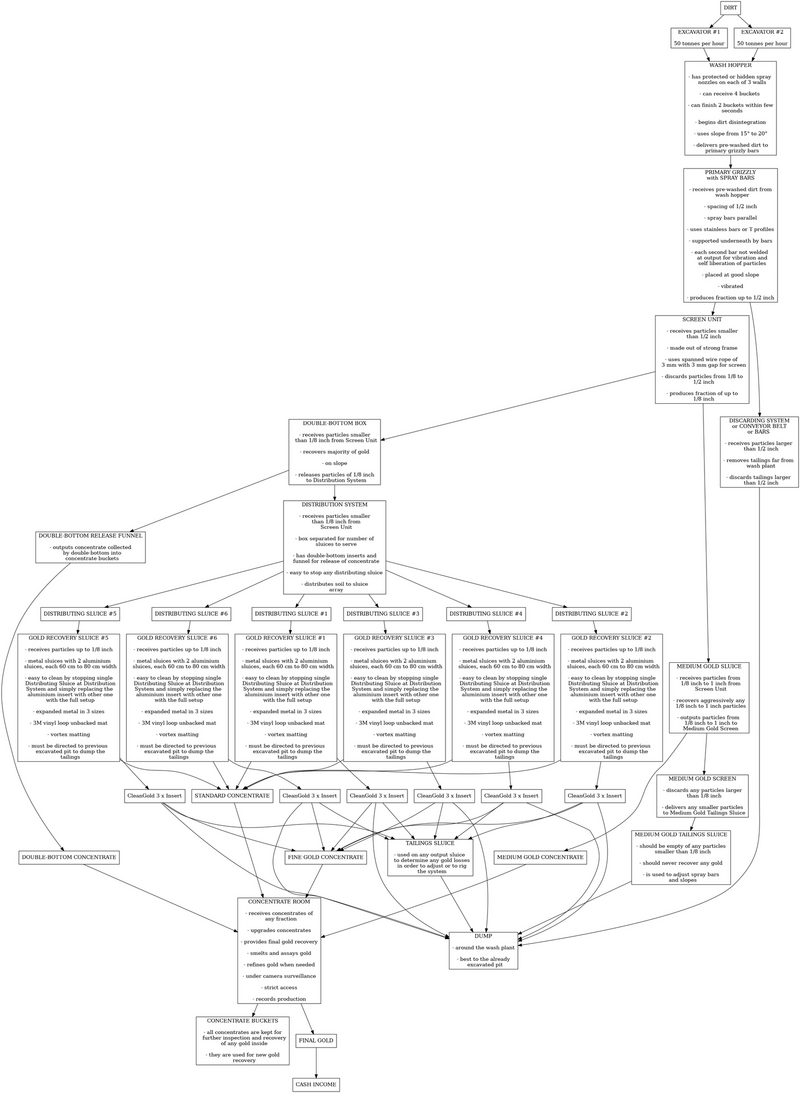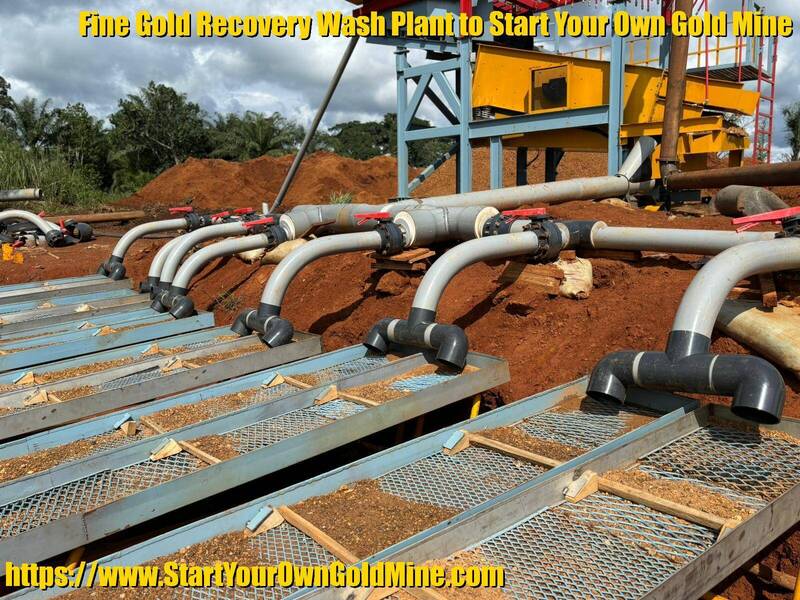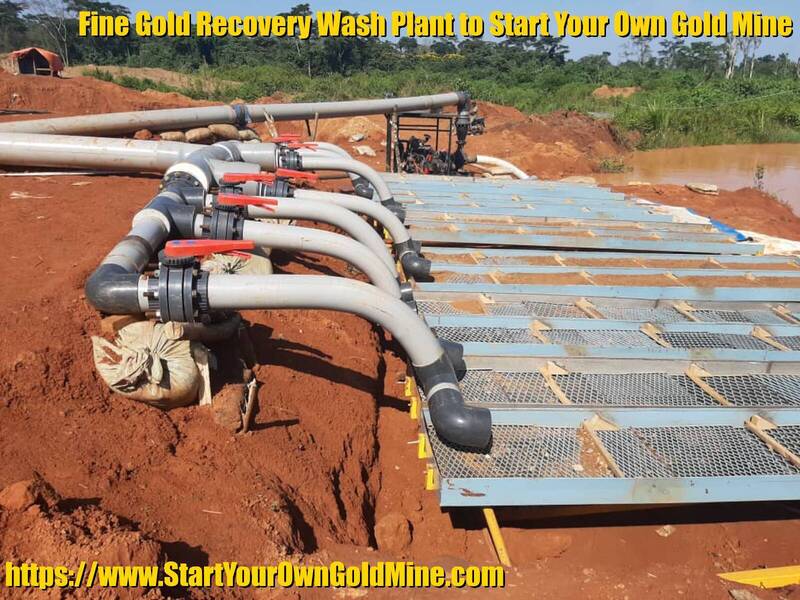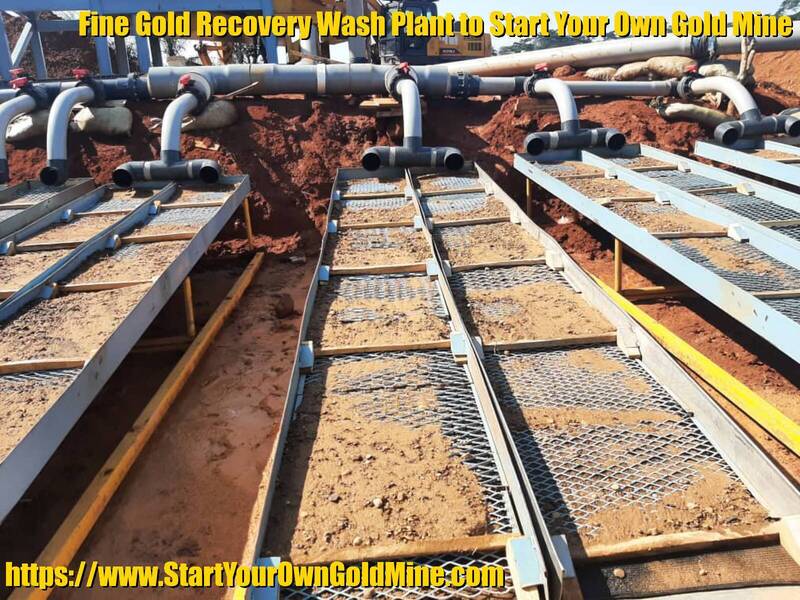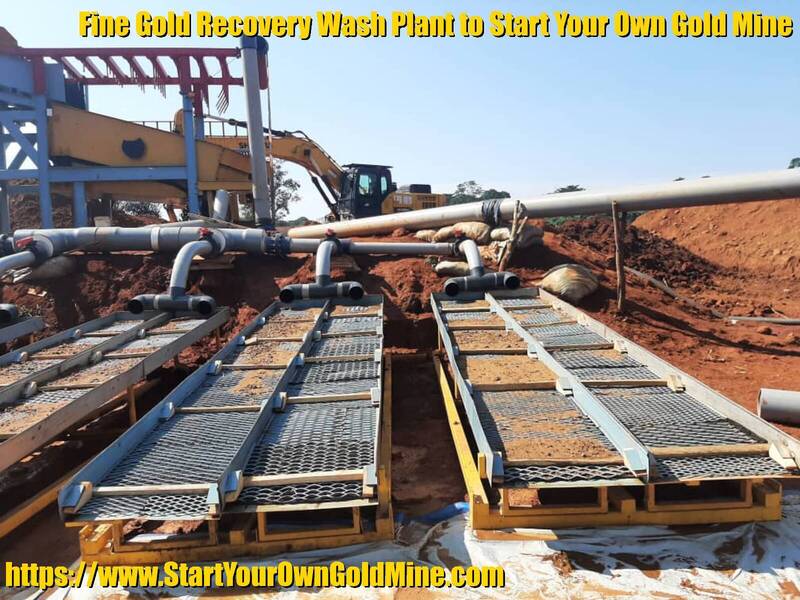- SYOGM Advance Wash Plant Design
- Related pages
SYOGM Advance Wash Plant Design
The SYOGM (Start Your Own Gold Mine) Advance Wash Plant is an innovative gold recovery system that allows miners to efficiently and effectively extract gold particles from dirt. The wash plant design incorporates various components and processes to ensure optimal extraction and recovery of gold.
The SYOGM Gold Wash Plant is designed for mobile alluvial or placer processing.
At Start Your Own Gold Mine, we specialize in designing wash plants for any capacity, from 30 to 300 tonnes per hour and more. Our expertise extends to include dredging boats, allowing miners to extract gold particles from riverbeds and underwater deposits. Our wash plant design incorporates state-of-the-art technology and components, ensuring efficient and effective extraction and recovery of gold. With our advanced system, miners can maximize their gold recovery while minimizing effort and resources. Whether you are a small-scale miner or operating on a larger scale, Start Your Own Gold Mine has the expertise and solutions to meet your gold extraction needs.
Components and Processes of the Gold Mining Wash Plant
Excavators
The wash plant is operated by one or more excavators which can process each about 50 tonnes of dirt per hour each. The effective operation and planning of excavators are essential for successful alluvial gold mining. It is crucial to adopt a systematic approach in order to maximize efficiency. Minimizing unnecessary movements, trucking, and excavations from one heap to another is of utmost importance. Every soil excavation should be directed straight to the wash plant in order to minimize expenses.
Dragline excavators are particularly well-suited for placer gold mining due to their exceptional ability to efficiently remove large volumes of overburden and sediment while minimizing ground disturbance. These heavy-duty machines are capable of digging deep into riverbeds or alluvial deposits to access gold-bearing materials that might be overlooked by smaller excavators. With their expansive reach and high digging capabilities, dragline excavators can place material directly onto the wash plant, streamlining the process and enhancing productivity. Additionally, their size allows for the handling of significant amounts of material in a single pass, which not only reduces the number of necessary movements but also optimizes the overall workflow. This efficiency translates to lower operational costs and higher yields, making dragline excavators an invaluable asset in the quest for placer gold.
A gold mining wash plant can be efficiently loaded with dirt using both pipes and conveyor belts. In alluvial mining sites, where soil is dredged from rivers or ponds, the plant can be conveniently connected to pipes to direct the soil straight into it. This enables a seamless process of extracting gold, as the plant receives a continuous supply of material, ensuring a smooth and efficient workflow. Additionally, the use of conveyor belts facilitates the transportation of materials to and from the wash plant, further optimizing gold mining operations.
Wash Hopper
The wash hopper is the first component that the dirt passes through. It features protected or hidden spray nozzles on each of its three walls, as well as additional nozzles on the frames above the wash hopper. The wash hopper can accommodate up to four buckets of dirt and disintegrates the soil while delivering pre-washed material to the primary grizzly bars. It has a slope that ranges from 15° to 20°. This slope is determined by the angle of repose under wet conditions and varies depending on the type of soil being mixed with water. It is crucial to emphasize the importance of spraying water in the wash hopper, as it serves as the initial entry point for soil into the system.
The functionality of the wash hopper is of paramount importance when designing and manufacturing gold wash plants. We emphasize that thorough testing of the wash hopper must be an integral part of our contractual agreement with clients. It is essential for the design to incorporate a detachable mechanism, allowing the wash hopper to be easily removed from the main structure of the wash plant for maintenance and optimization purposes.
To enhance the efficiency of the wash process, we advocate for the inclusion of 50 to 100 strategically positioned spray streams on the primary wash hopper. This configuration aims to maximize the initial disintegration of soil and facilitate the liberation of gold as the material enters the hopper. By optimizing the interaction between the water and soil, we ensure a more effective and efficient washing process, ultimately leading to improved gold recovery rates.
Primary Grizzly Bars
The primary grizzly bars receive the pre-washed dirt from the wash hopper. These bars have a spacing of ½ inch and are supported underneath by bars. The bars are not welded at the output every second bar, allowing for vibration and self-liberation of particles. The bars are placed at a good slope and vibrate to produce a fraction up to ½ inch.
Prior to determining the optimal slope angle for the gold wash plant, it is crucial to assess the angle of repose under wet conditions. This evaluation is essential, as it directly impacts the stability and efficiency of the operation. We emphasize that rocks containing gold may still hold significant economic value, even after crushing and milling. Therefore, we strongly recommend that operational manuals include guidance on incorporating additional machinery to maximize recovery and profitability from any discarded rock.
The primary function of the grizzly bars is to separate larger rocks, specifically those exceeding ½ inch in size. These oversized materials should be thoroughly washed to ensure that no clay or residual gold adheres to their surfaces, thereby enhancing the overall efficiency of the gold recovery process.
Screen Units
Particles smaller than ½ inch are received by the screen unit. The screen unit is made up of a strong frame and uses spanned wire rope with a 3 mm gap for the screen. It discards particles from 3/8" to ½ inch and produces a fraction of up to 3/8 inch.
In addition to the primary screen unit, additional screen units may be employed to further refine the particle size distribution. By using multiple screening stages, we can achieve a more uniform group of particle sizes, which significantly aids in the subsequent gold recovery process when using sluices. This uniformity allows for optimal flow and stratification during the sluicing phase, minimizing the risk of fine gold being lost among larger particles. As a result, the improvements in particle size consistency not only enhance the efficiency of gold recovery but also increase the overall productivity of the operation.
False-Bottom Box
Particles smaller than 3/8 inch from the screen unit first drop into the false-bottom box. The false-bottom box recovers the majority of gold and releases particles of 3/8 inch to the distribution system as overflow.
This is a primary gold collector. The box does not need to be frequently cleaned as the gold is collected in the gold collection funnel under the wash plant.
Vibrations and water spray from the machine ensure that the majority of gold drops into the false bottom and gets stuck there.
Gold Collection Funnel
The gold collection funnel is strategically located beneath the false-bottom box, serving as the initial gold recovery component of the wash plant. Its design facilitates the gradual accumulation of gold particles into the funnel. When operated correctly, the funnel can be utilized throughout the gold washing process without the risk of losing any gold.
Gold is transferred into a stainless steel pipe equipped with two valves. The upper valve is locked first, allowing the lower valve to release the gold into the collecting tube. To ensure that all particles are effectively extracted, the funnel pipe can be submerged in water, which helps dislodge any remaining gold. A specialized brush can be employed to thoroughly clean the pipe without losing any gold particles.
Once the cleaning process is complete, the bottom valve is locked, and the upper valve is opened to resume operation. This method guarantees maximum efficiency in gold recovery while minimizing potential losses.
Valves should be fitted with a padlock to guarantee the security of the gold.
Distribution System
The distribution system receives particles smaller than 3/8 inch from the screen unit. It is separated into multiple boxes to serve a number of sluices. The distribution system may also have false-bottom inserts and a funnel for the release of concentrate. It is easy to stop any distributing sluice and distributes soil to the sluice array.
It is crucial to emphasize that the distribution system should begin at a sufficient height to enable the slurry to flow freely towards the gold recovery sluices. Additionally, it should be positioned on both sides of the gold wash plant to ensure optimal mobility and a systematic approach.
Gold Recovery Sluices
For wash plants with a processing capacity of 60 tonnes per hour or more, we recommend utilizing three sets of sluices, each containing three sluices, resulting in a total of nine sluices positioned on both the left and right sides of the gold wash plant. This same configuration is also recommended for platform-based floating gold wash plants, which are, in fact, the most efficient option available.
Each sluice is designed to handle particles up to 3/8 inch in size. The metal sluices consist of two aluminum sections, each measuring 60 cm in width, a dimension that has proven to be user-friendly. Cleaning the sluices is a straightforward process; simply stop a single distributing sluice within the distribution system to replace the matting or entire sluice inserts. The sluices incorporate expanded metal in three different sizes, along with a 3M unbacked vinyl loop mat and vortex matting. The tailings collected from the sluices are channeled back into the previouslyexcavated pit.
All sluice sets are interconnected and can be easily transported; they can also be used individually in exploration mode. This allows for the deployment of six distinct sluice sets across six different locations, each requiring a minimum of three operators and capable of processing between six to ten tonnes per hour.
It’s important to note that it’s the width of the sluice that effectively recovers gold, rather than the length, which is a misconception often perpetuated by other gold wash plants. Due to transportation constraints, many plants utilize long sluices. However, longer sluices, combined with excessive water flow, can wash gold away, leading to significant losses that can outweigh the overall value of the wash plant.
Medium Gold Sluice
The medium gold sluice receives particles from 3/8 inch to 1 inch from the screen unit. It aggressively recovers any particles within this range and outputs them to the medium gold screen.
This sluice set is designed to capture medium-sized particles following the primary grizzly screens. It is essential to thoroughly inspect the rocks for gold nuggets, as this setup primarily targets larger gold particles, and the sluices are configured differently.
If, after a comprehensive examination, no larger gold nuggets are detected, it is possible to exclude this sluice box from the system; however, we do not recommend doing so.
Medium Screen
The medium gold screendiscards any particles larger than 3/8 inch and delivers any smaller particles to the medium gold size sluice.
Tailings Sluice
The tailings sluice is used on any output sluice to determine any gold losses and adjust or rig the system accordingly. It should be empty of any particles smaller than 3/8 inch and should never recover any gold. The tailings sluice is also used to adjust spray bars and slopes.
Water pump or water supply
The water pump is a crucial component of the gold wash plant, serving as the lifeblood of the entire operation. Its primary function is to provide a consistent and adequate supply of water, which is essential for the effective separation of gold from other materials in the ore. This powerful piece of machinery ensures that the wash plant operates efficiently, allowing for the proper washing and processing of gravel, sand, and other materials that may contain precious minerals. Without a reliable water pump, the plant would struggle to maintain optimal flow rates, leading to decreased productivity and potentially lower gold recovery rates. Additionally, the pump must be capable of handling various water conditions, including sediment-laden sources, which can impact its performance. As such, the quality and reliability of the water pump are pivotal for the overall success of gold mining operations, emphasizing its role as an indispensable element in the quest for extracting valuable resources from the earth.
The water pipes are designed to allow for adjustments in water flow, enabling an increase or decrease as needed. They also make it possible to attach separate hoses and utilize additional sluices in the wash plant.
Furthermore, in geographical regions where the land configuration allows for the implementation of an elevated water source, we strongly advocate for the strategic investment in piping systems to exploit this natural advantage. Utilizing gravity-fed water systems not only reduces the long-term operational costs associated with energy consumption required for water pumps but also provides a more sustainable and environmentally friendly solution for water distribution. By channeling water directly from a higher elevation, we can significantly enhance the efficiency of water delivery, ensuring a consistent and reliable supply for agricultural, domestic, or industrial needs. Moreover, this approach can mitigate potential mechanical failures and maintenance issues commonly associated with pump systems, leading to a more resilient infrastructure. Overall, embracing the use of gravity in water transport not only optimizes resource use but also fosters greater water security and sustainability in the communities that rely on it.
Concentrate Room
The concentrate room receives concentrates of any fraction and upgrades them. It provides final gold recovery, smelts and assays gold, and refines gold when needed. The concentrate room is under camera surveillance, has strict access control, and records production.
We take pride in the fact that our concentrate room is a product of our own manufacturing. It is designed with two distinct rooms to optimize functionality and efficiency. This mobile unit is easy to transport via truck, allowing for quick relocation as needed, or it can be constructed using available structures already present on your site.
Safety is our top priority, especially when it comes to the concentrate room, which is specifically designed to protect against theft. It is equipped with advanced security features, including comprehensive camera surveillance and strict access control measures. Only authorized personnel are allowed entry, and all activities are meticulously recorded to ensure accountability.
Within this secure environment, the concentrate room efficiently receives concentrates from any fraction and upgrades them through various processes. It facilitates final gold recovery, smelting, assaying, and, when necessary, the refining of gold, ensuring that the entire operation meets the highest standards of safety and quality.
Cleangold Inserts
The Cleangold inserts are used in the gold recovery sluices to collect the concentrates. Each sluice has three Cleangold inserts.
The Cleangold system represents the most advanced gravitation-based fine gold recovery technology available today, specifically engineered to maximize fine gold extraction while minimizing overall operational costs. This innovative system is capable of recovering gold particles as small as 5 microns, which are often invisible to the naked eye. Given that the majority of gold present in deposits is in the form of fine particles, the Cleangold technology plays an indispensable role in any effective gold wash plant. With each sluice equipped with three Cleangold inserts, the system ensures optimal capture of concentrates, ultimately enhancing the efficiency and profitability of the gold recovery process.
Concentrate Buckets
All concentrates are stored in designated buckets for further inspection and the recovery of any gold present. The bucket system can be considered the most crucial element of gold recovery, as it facilitates organization and sorting by particle size and the various stages the concentrates undergo during the upgrading process. Any startup company should obtain at least 100 sturdy, paint-like buckets before embarking on a placer or alluvial gold mining operation. The concentrate room is responsible for managing these materials, with the buckets providing an efficient means of handling them.
Final Gold and Cash Income
Once gold is extracted from concentrates, it must be smelted and assessed for purity in the concentrate rooms. Essential tools for this process include vials, tweezers, scales, density scales, induction smelting furnaces, crucibles, molds, borax powder, asbestos gloves, protective gear, laboratory vessels, microscopes, gold pans, magnets, and sieves. All of these components are integral to the final gold recovery equipment.
The final gold is collected and stored, ready for sale or further processing. It represents the cash income for the miners.
How the SYOGM Advance Wash Plant Works
The SYOGM Advance Wash Plant follows a series of processes to extract gold from dirt efficiently. Here is a step-by-step guide on how it works:
Excavators collect dirt and deposit it into the wash hopper.
The wash hopper disintegrates the dirt and delivers pre-washed dirt to the primary grizzly bars.
The primary grizzly bars vibrate to dislodge and liberate particles up to ½ inch in size.
The pre-washed dirt is then passed through the screen unit, which discards particles from 3/8 to ½ inch and produces a fraction of up to 3/8 inch.
Particles smaller than 3/8 inch are collected in the false-bottom box, where they are recovered, and again released to the distribution system.
The distribution system separates the particles smaller than 3/8 inch into different sluices for gold recovery.
The gold recovery sluices receive the particles and use expanded metal, vinyl loop unbacked mat, and vortex matting to capture and recover the gold.
The tailings from the sluices are directed to the previous excavated pit to discard any remaining materials.
The medium gold sluice aggressively recovers particles from 3/8 inch to 1 inch and outputs them to the medium gold screen.
The medium gold screen discards particles larger than 3/8 inch and delivers the smaller particles to the medium gold tailings sluice.
The tailings sluice is used to adjust spray bars and slopes and to determine any gold losses.
The concentrates from the gold recovery sluices are collected in the concentrate room, where they are upgraded and undergo further processing if necessary.
The final gold is stored for sale or further processing, representing the cash income for the miners.
All concentrates are kept in concentrate buckets for further inspection and recovery of any gold inside.
The SYOGM Advance Wash Plant design incorporates various components and processes to optimize the extraction and recovery of gold from dirt. It ensures efficient and effective gold recovery for miners in their own gold mines.
Technical School of Banja Luka
The Technical School of Banja Luka, Jean Louis' school, holds a special place in my memories. It was there, in the basement, where we engaged in metal filing, laying the groundwork for our technical skills. The amphitheater became our hub for fun and entertainment, while the challenges we faced with peers and professors taught us valuable life lessons. Our journeys to Rovinj and the technical drawings and mechanical principles we mastered shaped our growth. Though the hard work was daunting at times, it ultimately contributed to the creation of the SYOGM Advance Wash Plant Design, a testament to the foundation we built at this school.
Related pages
- Get Ready for Gold Rush: Essential Mining Equipment for Start Your Own Mine
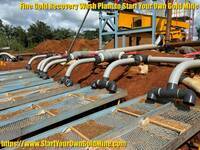 Start Your Own Gold Mine is a leading manufacturer and supplier of top-notch fine gold recovery equipment and expert guidance for small and medium-scale gold mining startups, ready to unlock the gold rush and full-scale mining potential.
Start Your Own Gold Mine is a leading manufacturer and supplier of top-notch fine gold recovery equipment and expert guidance for small and medium-scale gold mining startups, ready to unlock the gold rush and full-scale mining potential. - SYOGM Rock Impact Mill
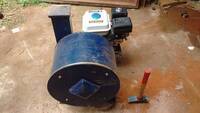 SYOGM Rock Impact Mill refers to low-cost, highly efficient, crushing and grinding impact mill with capacity of 500 kg and even up to 900 kg per hour. Capacity depends of the operator's skills and speed of work. This type of rock impact mill can easily replace rudimentary and very expensive ball mills such as those used in East Africa, in Tanzania, Uganda or Kenya or neighboring countries. While local village miners need to dry their rocks, this rock impact mill will work with water and without drying. It may process dry rocks as well. The machine may be transported by 2 people from a car to operating site. Or it may be transported by one person and wheelbarrow. Thus it is very mobile. Recovery screen is 1 mm and may be adjusted. We know from practical testing and scientific journal that screen of 1.5 mm is good enough to achieve almost optimum recovery. Thus our screen of 1 mm is more than enough to provide optimum recovery for small scale miners in East Africa and in other countries. This is pass-through grinding machine. It means that it may be used for very quick gold discovery and field sampling.
SYOGM Rock Impact Mill refers to low-cost, highly efficient, crushing and grinding impact mill with capacity of 500 kg and even up to 900 kg per hour. Capacity depends of the operator's skills and speed of work. This type of rock impact mill can easily replace rudimentary and very expensive ball mills such as those used in East Africa, in Tanzania, Uganda or Kenya or neighboring countries. While local village miners need to dry their rocks, this rock impact mill will work with water and without drying. It may process dry rocks as well. The machine may be transported by 2 people from a car to operating site. Or it may be transported by one person and wheelbarrow. Thus it is very mobile. Recovery screen is 1 mm and may be adjusted. We know from practical testing and scientific journal that screen of 1.5 mm is good enough to achieve almost optimum recovery. Thus our screen of 1 mm is more than enough to provide optimum recovery for small scale miners in East Africa and in other countries. This is pass-through grinding machine. It means that it may be used for very quick gold discovery and field sampling. - Terms and Conditions for Gold Mining Equipment Manufacturing by Start Your Own Gold Mine
 Start Your Own Gold Mine offers comprehensive terms and conditions governing the manufacture, sale, and use of specialized gold mining equipment.
Start Your Own Gold Mine offers comprehensive terms and conditions governing the manufacture, sale, and use of specialized gold mining equipment. - Strategic Provisioning of Equipment to Village Miners in Exchange for Gold Benefits (Relationship Management)
This web page talks about a way for dealers and buyers to work together that is good for both sides. The dealers or buyers give miners in villages the equipment they need for mining gold. This helps the miners mine gold more efficiently. In return, the dealers and buyers get some of the profits from the gold-bearing rocks, or they get a good percentage of any precious metals that are found. They also get priority when buying these valuable resources and get discounts on future transactions.

